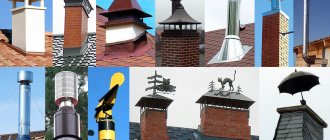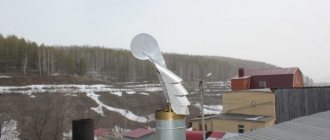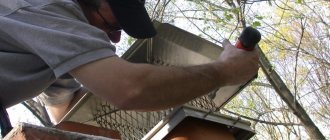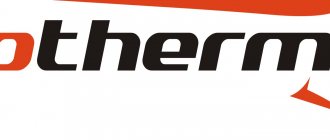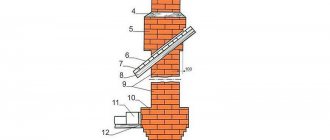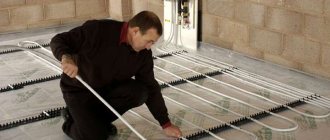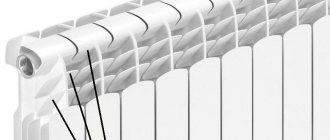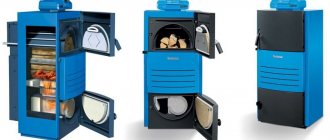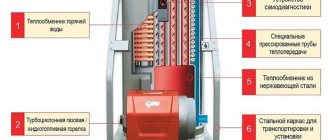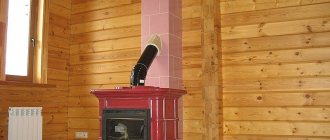In any house where stove heating is present, it is very important to create good draft in the chimney. A significant element in the gas exhaust system is a device that increases the rate of removal of combustion products. This design is called a deflector; it not only increases traction, but also protects the channel from debris or precipitation. The design of this product is quite simple, which allows you to make a chimney deflector with your own hands - the drawings from which you can make the design are clear and simple.
Important points in preparation for assembly ↑
There are many types of devices that increase chimney draft. There are quite easy-to-manufacture options that are popular - TsAGI, Grigorovich deflectors, chimneys mounted on brick pipes. Although such complex structures as weather vane deflectors have an advantage due to which they are also successful - these devices provide decent traction in any wind direction.
Chimney deflector
What is needed from materials and tools ↑
When creating any of these pipe nozzles to remove combustion products, you can use materials and tools that do not require such special skills as, say, the ability to work with a welding machine. To make a chimney deflector with your own hands, just use:
- a wooden or rubber mallet;
- metal scissors;
- roulette;
- ruler;
- special chalk for metal;
- electric drill;
- manual riveter;
- metal drills;
- hacksaw for metal;
- regular scissors;
- simple pencil.
Types of deflectors
It’s easy to make a device if you have:
- sheet metal, for example, galvanized iron;
- a metal strip or a small steel corner;
- aluminum rivets (drills are selected according to the diameter of the rivets);
- for fastening the product to the chimney, bolts and nuts;
- cardboard for preparing patterns.
Deflector diagram
The first stage of work is drawing up drawings and patterns ↑
Before you start making a chimney deflector with your own hands, prepare drawings on plain paper. For each option, there is a certain ratio that affects the efficiency of the device when removing gases. Therefore, a product diagram is created indicating the dimensions, according to which the required amount of materials will be calculated and patterns will be created for cutting sheet metal.
After preparing the drawings, patterns are made that are subsequently used to construct the elements of a particular device. Having made the necessary patterns, we begin to create a metal structure.
Grigorovich deflector
Purpose of the deflector
Installing a deflector allows you to solve the following problems.
- Protect the chimney pipe from clogging and moisture.During the off-season period, birds can make nests on it, the chimney becomes clogged with snow, and a large amount of water gets into it when it rains. The deflector completely eliminates the occurrence of such problems.
Without a deflector, the chimney quickly becomes clogged and needs to be cleaned. Reduce the negative impact of climatic factors on the chimney draft. As already mentioned, weather conditions can be so unfavorable that they cause backdraft, a very dangerous phenomenon.
In the presence of reverse draft, smoke and carbon monoxide go into the room, and not into the chimney. Increase the efficiency of chimneys within 15–20%. Due to this, it becomes possible to regulate their minimum length, improve the appearance of the building facade, and reduce the cost of installing elements.
The deflector allows you to minimize the cost of installing a chimney. Extinguish sparks. This is an additional function of the deflector and is important when determining the fire safety category of the roof.
The deflector extinguishes sparks, preventing accidental fire
The deflector consists of three main elements: a diffuser, an umbrella and a body. The diffuser changes the speed of movement of combustion products in the chimney pipe, the umbrella protects it from water and debris, and the housing cuts through air flows and creates a vacuum to increase draft. There are modifications with an installed protective mesh, but this addition slightly worsens the performance characteristics of the deflector.
Standard deflector design
The action of the deflector is explained by the Bernoulli effect: the speed of air flow has a direct relationship with the pressure in the channel. Air increases the speed of movement in a narrowed diffuser, due to this the pressure in the housing decreases and the draft in the chimney increases.
Grigorovich deflector - manufacturing stages ↑
The simplest product is the Grigorovich device, which is easy for most people to make.
Calculations and preparation of drawings ↑
When drawing drawings and sizing this product, the following ratio applies:
- the height of the structure is approximately 1.7d;
- the cap must be made with a width of 2d;
- The diffuser width should be about 1.3d.
Grigorovich's homemade deflector
The symbol d refers to the diameter of the smoke channel. If a different size ratio is used during manufacturing, this will negatively affect the efficiency of the created device.
Based on the drawn drawings, patterns are prepared that are used when cutting galvanized iron into elements, from which the product is then assembled. To do this, transfer the outline of the elements in expanded form and in full size onto the cardboard, using a ruler, tape measure and pencil. When making a deflector for a chimney pipe designed by Grigorovich, prepare patterns for the outer cylinder, diffuser and cap.
Diffuser calculation
Stages and nuances of making a deflector ↑
Next, the following work with metal is performed:
- Using prepared patterns, outlines of the necessary parts are applied to sheets of metal, outlining cardboard figures with special chalk. If special chalk is not available, you can use a simple pencil. Add 20 mm to the contour of the parts in places where they overlap, which will allow you to maintain the required configuration of the finished elements during assembly.
- Using metal shears, the elements necessary for assembly are cut out of galvanized metal, thereby preparing the expanded outer cylinder, diffuser, and both parts of the cap - the umbrella cap along with the reverse cone.
- Then, using a hacksaw, metal strips or a corner are cut into pieces of the required length, through which all the elements will be connected into the finished product.
- The parts are given the required shape by folding and bending them in a certain way.
- The next operation is assembling the product. The elements are placed on top of each other and, using an electric drill, the necessary holes are drilled. Using rivets placed in prepared holes, the parts are fastened together.
- To install the Grigorovich device on a chimney, you can use two options - in the first case, through holes are drilled at the mounting location, through which the structure is fixed with fasteners on the chimney, and in the second option, a clamp is made from a strip, through which the deflector is fixed to the pipe.
TsAGI chimney nozzle
Types of deflectors
| The most common option. It has a cylindrical shape and is made of stainless steel or galvanized steel. Connection type – nipple, flange |
Round Volper | The design is similar to the TsAGI deflector, but has slight differences in the upper part. Made of galvanized steel, stainless steel and copper, most often used for chimneys in bathhouses |
Grigorovich deflector | An improved version of TsAGI, designed for areas with prevailing low winds. Provides good traction even in calm weather |
Disc Astato | Very efficient and simple open design. Provides high-quality traction regardless of wind direction. Made from galvanized and stainless steel |
H-shaped | Reliable design, effective in any wind direction. Made of stainless steel, the connection is made using a cut-in on the device pipe |
Deflector-vane | A device with a rotating body and a weather vane attached to the top. Made from stainless steel or painted carbon steel |
Rotating deflector | The device rotates only in one direction, effectively protects the chimney from clogging and precipitation, and is excellent for gas boilers. Does not work in calm conditions or when icing |
The main differences are in the shape of the structure and the number of components. The material for the manufacture of such devices is stainless and galvanized steel, less often copper. They are cylindrical, square, round, open and closed in shape. Devices of the same type may differ in the upper part: some products are made with a cone-shaped umbrella, others have a gable or hip roof, others are made flat or with decorative figured elements.
The diameter of the deflector varies from 100-500 mm, the width of the diffuser from 240 to 1000 mm, the height of the structure - from 14 to 60 cm.
The device is attached to the chimney using brackets, clamps, bolts, and sealing tape. For manufacturing, steel with a thickness of 0.5 to 1 mm is used, depending on the diameter of the deflector itself. Additionally, the device can be equipped with a spark arrester if there is a risk of roof fire.
Deflectors with spark arrestors
Manufacturing procedure for the TsAGI deflector ↑
No less common is the device developed at the Central Aerohydrodynamic Institute (TsAGI). Thanks to its simple design, it will not be difficult to make such a deflector with your own hands.
Preparation of drawings and patterns ↑
Initially, drawings are prepared, during the preparation of which the dimensions of the product are calculated. The diameter of the chimney, indicated by the symbol d, is taken as a basis. When designing a product, use the following size ratio:
- the size of the wide part of the diffuser is 1.25d;
- ring diameter – 2d;
- ring height – 1.2d;
- distance from the lower edge of the ring to the narrow part of the diffuser – d/2;
- diffuser height – d/2 + 1.2d;
- umbrella width – 1.7d.
TsAGI nozzle size ratio
The ease of assembling the product from elements created using such templates depends on how correctly the patterns are made, and in the future this will affect the efficiency of the design. It is necessary to prepare patterns for the following parts:
- diffuser;
- inlet pipe;
- ring;
- umbrella.
Features of creating diffuser and umbrella templates ↑
To make a diffuser pattern, it is necessary to make the correct calculation, which will result in a figure with the required contour. To do this, you need to use the option of creating a truncated cone. The following is taken as the data on which the calculation will be based:
- chimney diameter – d1;
- diameter of the circle by the amount by which the diffuser increases in the wide part – d2;
- diffuser height – H.
Preparing the Umbrella Template
It’s easier with an umbrella pattern. It is necessary to draw a circle whose diameter will be equal to 1.7d. Next - two radius lines so that the angle between them is 30°. Then cut out a pattern from cardboard, not forgetting to cut out the area located between the two radius lines.
The templates for the outer ring and inlet pipe are rectangular in shape, so making them will not be difficult.
Procedure for manufacturing the TsAGI deflector ↑
After preparing the templates, work with metal begins. When making a deflector for a pipe with your own hands, do the following:
- Using patterns, the necessary contours of parts are drawn on the metal. At the same time, 20 mm are added in places of overlap. The lines are drawn with special chalk or a simple pencil.
- Using metal scissors, cut out the parts along the drawn contour in expanded form.
- Using a hacksaw, metal strips or a metal corner are cut into pieces of the required length - these pieces will be used to fasten structural parts made of galvanized iron.
- The cut out elements are bent properly, holes are made in the overlapping areas, and the edges are fixed with rivets.
- Next, the product is assembled - the elements are drilled in places where they overlap each other, and through the resulting holes the parts are secured relative to each other with rivets.
- The structure can be attached to the chimney in two ways: make holes for fastening in the inlet pipe, or additionally make a clamp from a metal strip, for which you will need a bolt and nut.
Adapter option for rectangular chimney
DIY making
To make the device you will need a drill, a sheet of thick paper, galvanized sheet metal, metal scissors, a pencil or a scriber.
First, you need to make a paper pattern of the component parts of the product - a cap, a diffuser, an outer cylinder.
We assemble a deflector from patterns. If everything matches, the work can be transferred to metal.
We place the paper patterns on galvanized sheet metal and trace them with a scriber. Using metal scissors, we cut out the parts along the cutting lines.
We roll up the diffuser and connect the edges with bolts or spot welding, or rivets. The bends are riveted.
Assembling the outer cylinder is similar to assembling the diffuser. The cap is rolled into a cone, the edges are connected in a way convenient for us.
Twenty centimeters long and about seven centimeters wide, metal strips are cut out, bent with a hammer, and attached to the cap. Using the same strips, the umbrella is attached to the diffuser and the whole thing is inserted into the cylinder.
The Grigorovich deflector, if we decide to make it, is complemented by a reverse cone and an increase in the protective umbrella by four centimeters in diameter.
To attach the reverse cone to the large cone, cuts are made at equal distances about eight petals and they are bent inward. This way the reverse cone is secured in the protective umbrella.
If the system operates in an aggressive environment, then it is better to make the fan from stainless steel, plastic, metal-plastic, and corrosion-resistant materials.
The Russian aircraft designer D.P. Grigorovich treated the deflector as an invention. And the mathematician A.F. Volpert, who formed a symbiosis of design thought with him.
First, they calculated an ordinary umbrella with unusual properties. A.D. Volpert suggested putting a diffuser on the umbrella. Then, after testing in a wind tunnel, the TsAGI deflector was “born,” which is still the most reliable and widespread. The evolution of the hood has led to the creation of a completely closed device that works in any conditions.
Atmospheric precipitation, dust, and ice from the outside have almost no effect on its operation. Dynamic loads are not scary either. The complexity of the design and assembly are its only drawbacks.
If you take on making a product with your own hands, then it would be good to learn some techniques of tin work - seam joining, lying or standing, learn how to make patterns for parts.
The double-decker umbrella does not clog for a long time and retains traction.
Candidate of Technical Sciences. Head of the Center for Educational Standards and Programs of the Moscow State University of Civil Engineering (National Research University "MGSU").
Source
Making a chimney nozzle with a square or rectangular cross-section ↑
When creating a chimney deflector with a square or rectangular cross-section, you can use two design options.
Use of an adapter in the design ↑
Initially, a drawing and a template are prepared, according to which the adapter will be cut out of galvanized steel in expanded form.
Drawing of an adapter for a deflector on a chimney with a rectangular cross-section
After preparing the patterns, they move on to working with metal:
- Using a pattern, apply the outline of the adapter to galvanized metal. It is necessary not to forget about the overlap area, adding 20 mm to the contour.
- Use metal scissors to cut out the product.
- Then the flat element is bent in such a way as to obtain a product of the desired shape.
- In the place of overlap, holes for rivets are made using an electric drill.
- Use a hand riveter to secure the overlapping edges of the adapter.
- To attach to the chimney, holes are made through which the adapter will be fixed to the pipe using fasteners.
- At the junction of the device and the adapter, holes are also made for the coupling bolts.
Chimney for a rectangular chimney
Technology for creating a simple chimney ↑
The second option is to make a canopy attached to a rectangular chimney. Anyone can figure out the task of how to make a chimney on a pipe with their own hands, since the design is extremely simple and the calculations are simple.
The drawing is prepared on the basis of calculations, thanks to which the required dimensions of the product are determined. Then, based on the drawing, patterns are created that are used to draw the contours of parts onto a sheet of galvanized iron.
Drawing of a chimney for a rectangular chimney
After preparing the template, we begin to manufacture the product itself:
- Using patterns, with special chalk the contours of an unfolded smoke umbrella are applied to a sheet of galvanized iron. It is necessary not to forget about the overlap areas, adding 20 mm to the connection of the edges of the part.
- Using metal scissors, cut out the parts according to the drawn outline.
- Using a hacksaw, cut a metal strip or corner into pieces of the required length. To fix the deflector on the chimney, it is most convenient to use a corner.
- The parts cut from the sheet are bent so that the smoke umbrella takes the required shape.
- Next, the product is assembled by drilling holes in the right places and fixing the parts with rivets.
Option for manufacturing a weather vane deflector
Self-production of a weather vane deflector ↑
The weather vane allows you to reduce the height of the pipe by increasing traction, since it is always in the right relationship with respect to the wind, prevents precipitation from entering the pipe and decorates the roof.
Tools and consumables for work ↑
To make one of the options for a weather vane on a chimney pipe with your own hands, you need to add to the above tools and materials:
- set of wrenches;
- pipe section;
- a metal (preferably stainless steel) rod or a ready-made pin;
- die for cutting threads on the rod;
- tap for cutting threads for fixing bolts;
- bolts for fixing bearings in the pipe;
- 8 nuts that will need to be screwed onto the rod to secure the bearings and secure the deflector housing.
- two bearings, the size of which is selected according to the diameter of the rod and the internal diameter of the pipe.
Drawing of a deflector in the form of a weather vane
Step-by-step instructions and important notes ↑
Operating procedure:
- Initially, a drawing is made, according to which patterns for parts are then made from a sheet of galvanized steel.
- Using patterns, apply the contours of the deflector elements onto a steel sheet with a special chalk or marker.
- Metal scissors are used to cut out parts from a metal sheet.
- The deflector body is assembled from the prepared elements by drilling holes and fastening them with rivets. You must remember to make brackets with which the body will be mounted on the rod.
- Cut off a rod or pin of the required length so that it is enough to secure the bearings and fix the deflector body.
- If a rod is used, the thread is cut using a die.
- Next, two bearings are attached to the stud with the distance between them necessary to create sufficient support when the deflector-vane rotates. To secure each bearing, first screw on the first nut, then put the bearing on the axle, then screw on the second nut and tighten the nuts until the bearing is well secured.
- Cut the pipe to the required length.
- Holes are made in the pipe where the bearings are located. Use a tap to cut the threads for the bolts that will secure the bearings in the pipe. Holes are also prepared for attaching supports that secure the entire device.
- A ring is made from a steel strip to secure the deflector to the chimney.
- Cut sections used as supports for attaching the block with bearings to the ring securing the product to the chimney.
- The final assembly of the product is carried out using rivets and fixing bolts.
Decorative weather vane
There are many options on how to make a deflector for a pipe with your own hands. Everyone chooses for themselves what type of device is best suited. It is only necessary to note that such a design, placed on a pipe to remove combustion products, performs several useful functions - it increases draft when removing gases, protects the chimney from debris and precipitation getting inside. After installing the deflector on the chimney, the heating efficiency in the house increases significantly.
Operating principle of deflectors
Operating principle of deflectors
The standard device includes three main elements - a cylinder, a diffuser, and a protective cap (umbrella). Additionally, the design is equipped with ring bumpers, which are located in the lower part and around the diffuser. There are several types of deflectors that differ in shape, size and number of elements, but all of them, regardless of type, work on the same principle.
The structure is installed at the very top of the chimney and creates an obstacle to air flow. When the wind hits the walls of the cylinder, it loses its strength and breaks up into many small air currents of low intensity. Some of them rise up the body and capture the smoke coming out of the chimney. This is what increases draft in the chimney duct.
Due to the absence of turbulence, smoke and carbon monoxide do not fall back into the pipe, but are completely removed outside. In addition, the deflector prevents the pipe from clogging through the top and performs decorative functions.
It has been proven that after installing the deflector, the efficiency of the heating device increases by 15-20%. Of course, the deflector itself will not give anything if the chimney is not installed high enough or the cross-section of the connecting pipe is incorrectly selected. The location of the pipe on the roof also matters.
